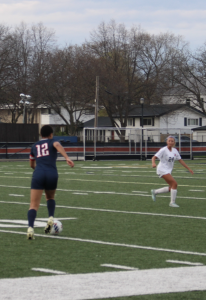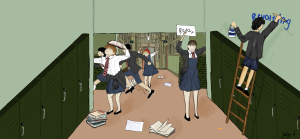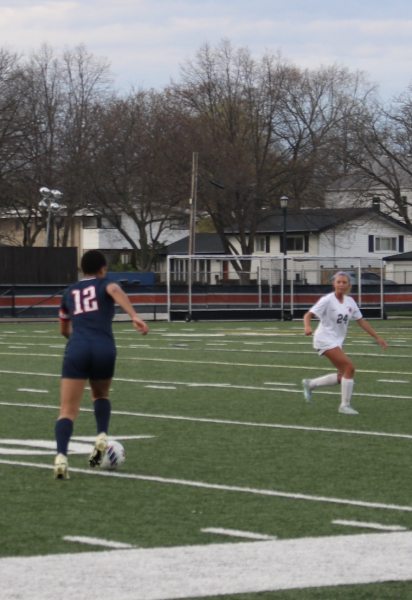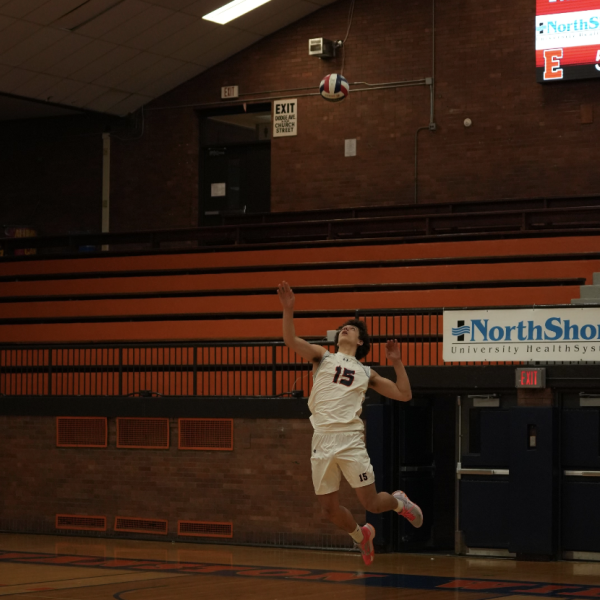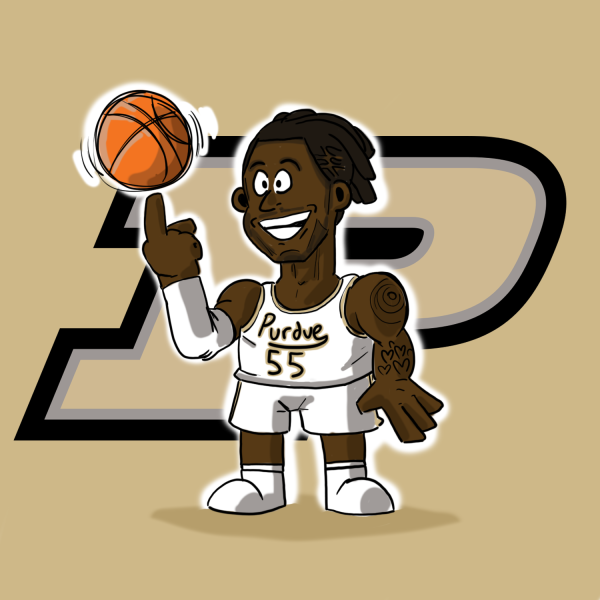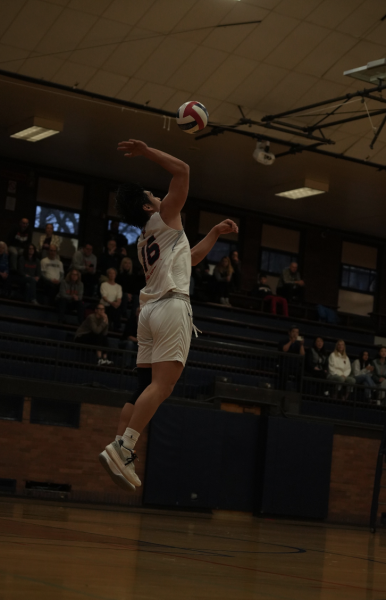Balancing a passion: the effects of being a student-athlete
December 13, 2019
Athletes work hard to perfect their craft on the field, and it’s no different in the classroom. With their exceptionally improved grade point averages and attendance rates compared to students who aren’t involved in athletics, athletes are more successful in their classes than their counterparts.
ETHS’ data from the 2018-2019 school year concluded that athletes do indeed earn a higher GPA over non-athletes. The average GPA of a one sport athlete at Evanston is a 3.63, as for a non-athlete, it is 3.08. With the immense difference in scholarly stats, there is a distinction to be made between one sport, two sport and three sport athletes.
At ETHS, sports programs have a freshman level, some may have Frosh Soph, all have junior varsity (JV) and all have varsity teams. The time commitment contrast between the freshman level and varsity level is fairly vast itself, and that’s before multiple sports are added to the conversation. Although athletes have proven to succeed academically, what’s the cost? With daily practices, homework and studying that needs to be done, self care and social lives are almost non-existent during season.
One Sport:
During season, while athletes are at daily practices and games and taking part in extracurriculars, their social lives are often eclipsed under constant academic improvement.
“In season, baseball is a huge time commitment,” senior varsity baseball player Seth Shimelfarb-Wells explained. “It affects my free time which affects many other facets of my life. I get my homework done but never when I should. I love sports because of what I get from it, but I never liked the tied down feeling that comes with the season.”
Balancing a sport with extracurriculars can be much easier as an underclassmen because they often do not have the added rigor of more difficult classes. By the time junior and senior year comes around, it can become a balancing act just to play one sport. Additionally, burning out, defined by The HelpGuide as a state of emotional, physical and mental exhaustion caused by excessive and prolonged stress, is very real for athlete’s focused on one sport. Some spring sports host non-mandatory “mandatory” offseason programs starting as early as September. These workouts are as often as four times a week. If a varsity athlete or a contending varsity athlete doesn’t show up, it is frowned upon. With the stress of finishing homework, possible extra curricular activities and maintaining a social life, students are mentally tired without the additional practices. These pre-season workouts along with off season club teams provide an increased chance for burnout. The stress that sports put on student-athletes seems to be too much for an activity that is supposed to be fun, causing burnout which can start long before their season even begins. While it is a big commitment to make, positive correlations are definitely found as well. As previously stated, the GPA between athletes and non-athletes is very steep.
“I definitely think that the structure is beneficial to me for my homework, but it definitely is a challenge too. On the days that I’ve gone from school to workouts to practice, all I want to do is go home and sleep,” senior softball player Molly Chambers explained. “My softball schedule makes me think ahead about when I can get a lot done/be the most productive.”
Two Sport:
According to data from the 2018-19 ETHS school year, 36% of all athletes play multiple sports at ETHS. This is a lot easier to do at lower levels than it is at the varsity level— 22% of freshman athletes play multiple sports, 18.5% of sophomore athletes play multiple sports with a drop off junior year at only 10.5% of athletes playing multiple sports and a grand total of 6% of athletes in multiple sports by senior year.
“During the off-season and summer, I go to football from 2-5 p.m. and basketball from 5-7 p.m. I workout for basketball around my football schedule because once football is over, I go right into basketball season the very next day,” senior football and basketball player De’Vaughn Bell explained. “With school work on top of that, it can be pretty difficult. But I get up early enough to go to AM support everyday, and I also try to sneak in as much work as I can during my three free periods including lunch.”
Bell also highlights a large reason why keeping his grades up are important to him, and all other athletes and also why two sport athletes have an average GPA of 3.78, .15 points higher than one sport athletes. “Playing two sports helps with keeping up with grades, because you can’t play football or basketball without having the grades. We get a lot of help not only from the teachers but from the coaches and teammates as well,” Bell said.
Eligibility is a serious factor at any level for all sports. If student-athletes are receiving two or more grades below a C-, they are put on Study Table and thus ineligible for the week until their grades improve. This helps prevent students-athletes from taking their foot off the gas in the classroom and compels them to show up to school as much as possible.
“[School] attendance shows a complete improvement as you go from one to two to three sports. Attendance rates get better and better, which makes sense. If players miss school, they miss practice, which hurts their playing time, so people don’t miss school when they’re in season,” Athletic Director Chris Livatino explained.
Multiple sports provides structure. This is shown by an average of 9.4 absences per year (including excused absences) for two sport athletes, compared to a whopping 19.2 average absences for students that play no sports.
Three Sport:
Three sport athlete. A term that is becoming increasingly unusual, especially as students move up to the varsity level. The question must be posed, what makes playing three sports such a phenomenon?
“If you add [school] work to it, I don’t know if it’s even possible, I hate to say it,” Livatino explained. “On top of that workload, at least one of those three sports will most likely require you to participate on a club [team], and that’s the other kiss of death.”
Not only are student-athletes expected to be able to complete the same assignments as classmates who are involved in no extracurriculars, the competitive nature that varsity sports creates makes students feel obligated to do outside club teams in order to excel within the team. Being a three-sport athlete is very time consuming and physically draining. Having to be in-season for the majority of the year with no breaks can take a toll on grades and mental health.
A study done by the National Center of Biotechnology Information tracked the moods of 465 college athletes for three years. The results explained that 24% of these athletes were clinically depressed and that female athletes were twice as likely to have depression symptoms than male athletes. With the constant need to continue to perfect their craft, athletes are often given no breaks.
“It’s [the time commitment] a lot,” junior field hockey, soccer and former basketball player Alyssa Kimmel said. “You’re always going to have that commitment on top of school and social life.”
Students are mentally wiped after a long, hard day at school. For Kimmel, that’s only the half of it. When asked how much time she gets for herself, she explains that she gets minimal unwinding time on weeknights.
“I normally get home from a practice or a workout, shower, eat, do my homework and then go to bed,” Kimmel explained. “The weekends are when I get to use most of my time for myself.”
Evidently, being routinely busy negatively impacts a student-athlete’s mental and physical abilities, but being a part of a team is special. Not only are student athletes more likely to get better grades, they are also taught important life-long skills when it comes to working together. A bond between a team is unbreakable, and being able to work well with each other makes for improved personal traits.
“I’ve been able to make great new friends, learned how to work with others and to be accountable for my actions,” Kimmel said. “Being a part of a team means you have to work as a unit and give your all. I’ve always had to be responsible for my actions and think about how they will affect my team in a game setting.”
Being a team player means an athlete has to have good communication and teamwork skills, as well as make good choices and have pristine time management skills, which all lead back to the stress of student athletes.
“Once I get home, doing homework it vital because once I begin to procrastinate, time goes by which results in me doing little to no work or cramped studying or even not doing it at all,” junior swimmer and track runner Olamide Thomas said. Thomas is also apart of Team ASAP, AVID Leadership Board, DECA, Student Ambassadors, Black Student Summit Committee and the Student Council.
Between one and two sport athletes, the GPA is at an increasing trend. Unfortunately, the trend begins to decrease after two sport athletes. Three sport athletes barely have a higher GPA than one sport athletes, 3.69 and 3.63 respectively. But it makes sense. Persistent studying is tiresome. All that an athlete wants to do after they got home from a long day is relax and unwind, which, as Thomas has experienced, leads to cramming for tests or just completely blowing off studying.
Student athletes are students first. Nothing is supposed to come before academics. Clearly, that isn’t the case. Continuous practicing and competitions leaves no time for studying or homework. Mental health, social lives and taking part in other hobbies and extracurriculars that one may like all go down the drain during season.





